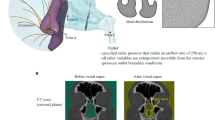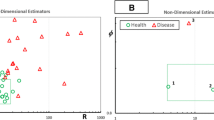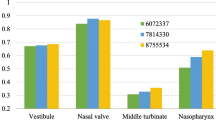Abstract
Nasal septum perforations (SP) are characterized by nasal obstruction, bleeding and crusting. The disturbed heating and humidification of the inhaled air are important factors, which cause these symptoms due to a disturbed airflow. Numerical simulations offer a great potential to avoid these limitations and to provide valid data. The aim of the study was to simulate the humidification and heating of the inhaled air in digital nose models with three different SPs and without SP. Four realistic bilateral nose models based on a multi-slice CT scan were created. The SP were located anterior caudal, anterior cranial and posterior caudal. One model was without SP. A numerical simulation was performed. Boundary conditions were based on previous in vivo measurements. Heating and humidification of the inhaled air were displayed, analyzed in each model and compared to each other. Anterior caudal SPs cause a disturbed decrease of temperature and humidity of the inhaled air. The reduced temperature and humidity values can still be shown in the posterior nose. The anterior cranial and the posterior caudal perforation have only a minor influence on heating and humidification. A reduced humidification and heating of the air can be shown by numerical simulations due to SP depending on their localization. The anterior caudal SP representing a typical localization after previous surgery has the biggest influence on heating and humidification. The results explain the typical symptoms such as crusting by drying-out the nasal mucosa. The size and the localization of the SP are essential for the symptoms.



Similar content being viewed by others
References
Schultz-Coulon HJ (1997) Septumverschlussplastiken nach der Brückenlappentechnik bei 126 Patienten–eine Analyse. Laryngorhinootologie 76(8):466–474
Fairbanks DN, Fairbanks GR (1980) Nasal septal perforation: prevention and management. Ann Plast Surg 5(6):452–459
Teymoortash A, Hoch S, Eivazi B et al (2011) Experiences with a new surgical technique for closure of large perforations of the nasal septum in 55 patients. Am J Rhinol Allergy 25(3):193–197
Pedroza F, Patrocinio LG, Arevalo O (2007) A review of 25-year experience of nasal septal perforation repair. Arch Facial Plast Surg 9(1):12–18
Becker SS, Dobratz EJ, Stowell N et al (2008) Revision septoplasty: review of sources of persistent nasal obstruction. Am J Rhinol 22(4):440–444
Mlynski G, Grützenmacher S, Plontke S et al (2001) Correlation of nasal morphology and respiratory function. Rhinology 39(4):197–201
Lindemann J, Kühnemann S, Stehmer V et al (2001) Temperature and humidity profile of the anterior nasal airways of patients with nasal septal perforation. Rhinology 39(4):202–206
Lindemann J, Leiacker R, Stehmer V et al (2001) Intranasal temperature and humidity profile in patients with nasal septal perforation before and after surgical closure. Clin Otolaryngol Allied Sci 26(5):433–437
Pless D, Keck T, Wiesmiller K et al (2004) Numerical simulation of air temperature and airflow patterns in the human nose during expiration. Clin Otolaryngol Allied Sci 29(6):642–647
Pless D, Keck T, Wiesmiller KM et al (2004) Numerical simulation of airflow patterns and air temperature distribution during inspiration in a nose model with septal perforation. Am J Rhinol 18(6):357–362
Lee HP, Garlapati RR, Chong VFH et al (2010) Effects of septal perforation on nasal airflow: computer simulation study. J Laryngol Otol 124(1):48–54
Grant O, Bailie N, Watterson J et al (2004) Numerical model of a nasal septal perforation. Stud Health Technol Inform 107(Pt 2):1352–1356
Lindemann J, Rettinger G, Kröger R et al (2013) Numerical simulation of airflow patterns in nose models with differently localized septal perforations. Laryngoscope 123(9):2085–2089
Sommer F, Kroger R, Lindemann J (2012) Numerical simulation of humidification and heating during inspiration within an adult nose. Rhinology 50(2):157–164
Garcia GJM, Bailie N, Martins DA et al (2007) Atrophic rhinitis: a CFD study of air conditioning in the nasal cavity. J Appl Physiol 103(3):1082–1092
Naftali S, Rosenfeld M, Wolf M et al (2005) The air-conditioning capacity of the human nose. Ann Biomed Eng 33(4):545–553
Lindemann J, Keck T, Wiesmiller K et al (2006) Nasal air temperature and airflow during respiration in numerical simulation based on multislice computed tomography scan. Am J Rhinol 20(2):219–223
Lindemann J, Keck T, Wiesmiller KM et al (2005) Numerical simulation of intranasal air flow and temperature after resection of the turbinates. Rhinology 43(1):24–28
Lindemann J, Brambs H, Keck T et al (2005) Numerical simulation of intranasal airflow after radical sinus surgery. Am J Otolaryngol 26(3):175–180
Lindemann J, Keck T, Wiesmiller K et al (2004) A numerical simulation of intranasal air temperature during inspiration. Laryngoscope 114(6):1037–1041
Wiesmiller K, Keck T, Leiacker R et al (2007) Simultaneous in vivo measurements of intranasal air and mucosal temperature. Eur Arch Otorhinolaryngol 264(6):615–619
Lindemann J, Keck T, Scheithauer MO et al (2007) Nasal mucosal temperature in relation to nasal airflow as measured by rhinomanometry. Am J Rhinol 21(1):46–49
Lindemann J, Leiacker R, Rettinger G et al (2002) Nasal mucosal temperature during respiration. Clin Otolaryngol Allied Sci 27(3):135–139
Keck T, Leiacker R, Heinrich A et al (2000) Humidity and temperature profile in the nasal cavity. Rhinology 38(4):167–171
Keck T, Leiacker R, Riechelmann H et al (2000) Temperature profile in the nasal cavity. Laryngoscope 110(4):651–654
Keck T, Leiacker R, Lindemann J et al (2001) Endonasales Temperatur- und Feuchteprofil nach Exposition zu verschieden klimatisierter Einatemluft. HNO 49(5):372–377
Grützenmacher S, Mlynski R, Lang C et al (2005) The nasal airflow in noses with septal perforation: a model study. ORL J Otorhinolaryngol Relat Spec 67(3):142–147
Hörschler I, Brücker C, Schröder W et al (2006) Investigation of the impact of the geometry on the nose flow. Eur J Mech B Fluids 25(4):471–490
Keyhani K, Scherer PW, Mozell MM (1995) Numerical simulation of airflow in the human nasal cavity. J Biomech Eng 117(4):429–441
Author information
Authors and Affiliations
Corresponding author
Additional information
J. Lindemann and M. Reichert contributed equally and shared authorship.
Rights and permissions
About this article
Cite this article
Lindemann, J., Reichert, M., Kröger, R. et al. Numerical simulation of humidification and heating during inspiration in nose models with three different located septal perforations. Eur Arch Otorhinolaryngol 273, 1795–1800 (2016). https://doi.org/10.1007/s00405-015-3818-z
Received:
Accepted:
Published:
Issue Date:
DOI: https://doi.org/10.1007/s00405-015-3818-z




